10 Midcentury Modern Colors for Every Room in Your Home
Neutrals and bold pops of color give this retro style its characteristic look.
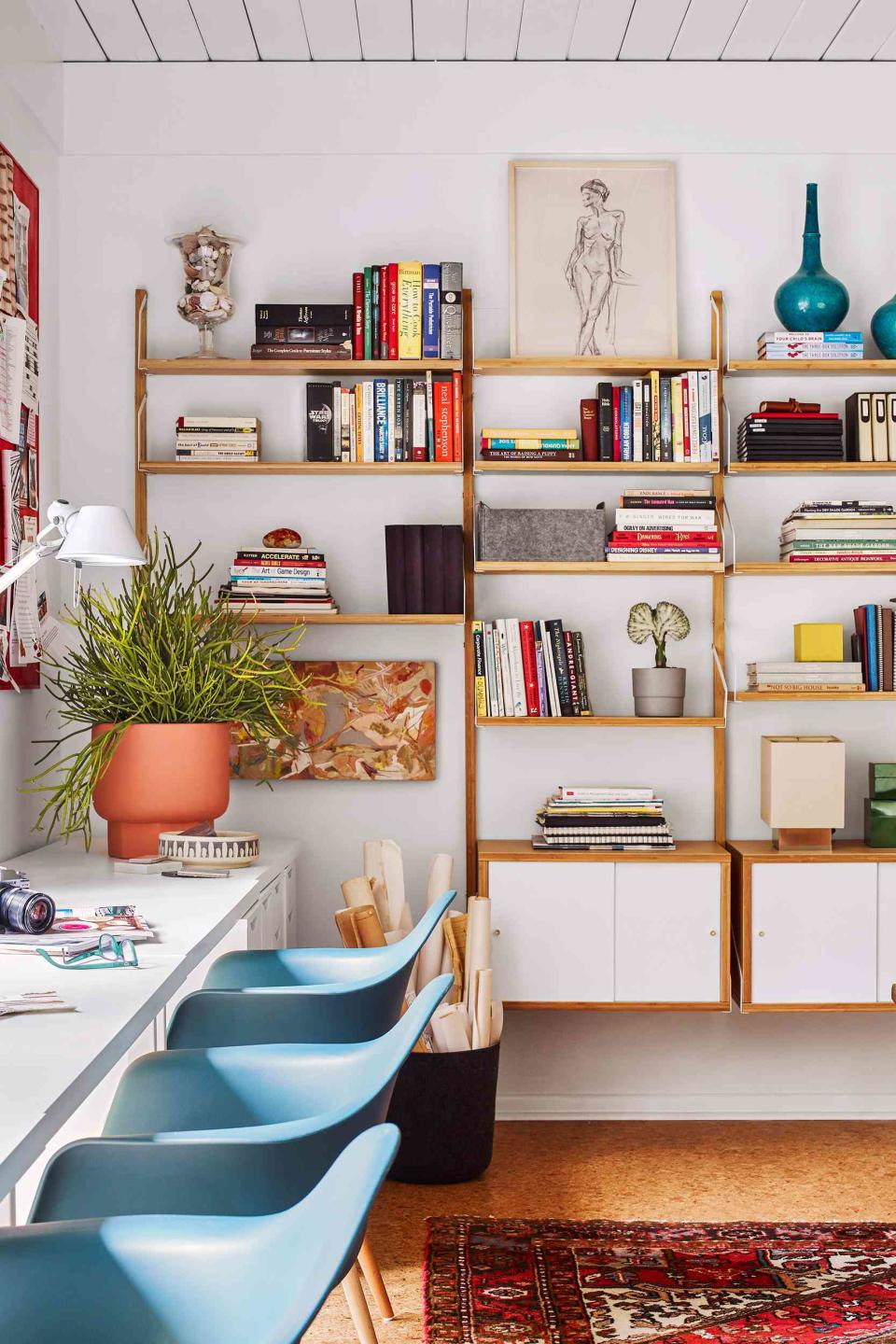
Emily Followill
Midcentury modern design took the world by storm in the late 1940s and its popularity flourished for the next two decades. Characterized by clean lines, natural wood elements, and curved designs, the style has made a comeback in recent years. From furniture and artwork to architecture and interior modern color palettes, the timeless midcentury aesthetic, along with its functionality and simplicity, continues to enjoy huge popularity.
When it comes to the design style's characteristic colors, they can be summed up as tonal neutrals with pops of bold color. Taking cues from nature and staying away from overly ornamental decorations, the style is streamlined elegance at its best. Browse through this collection of rooms to learn about classic midcentury modern colors and how to incorporate them into your own home.
Wood Tones
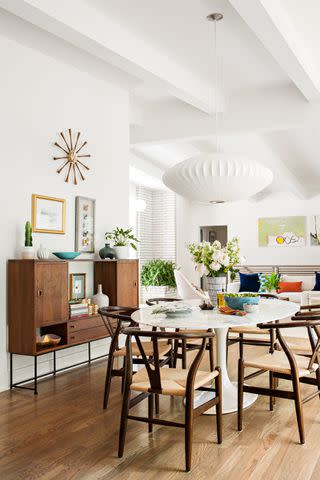
Anthony Masterson
Rich wood tones and warm white walls form a neutral color palette in an open-concept living space. Furniture pieces synonymous with midcentury modern design, including a tulip dining table and wishbone chairs, set the color scheme, while decorative accents used throughout the dining and living rooms add a pop of color.
Navy blue and orange throw pillows brighten up a white sofa, green and yellow artwork adorns the walls, and turquoise pottery completes the look. This minimal color palette allows finishes—hardwood floors, white ceiling beams, and stylish furniture—to shine and gives the home an airy, uncluttered feel.
Black Backdrop
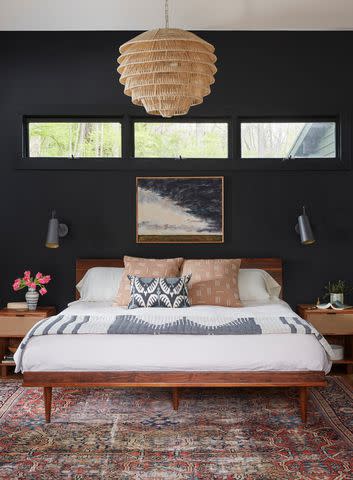
A stark black accent wall sets a dramatic tone in a midcentury modern bedroom. The deep wall color is softened with a set of three glass windows, a distressed vintage-style area rug, cozy white bedding, and a sculptural rattan chandelier. The limited color palette relies on texture, furniture design, and mixed materials to make a statement. Faded blues and reds accent an earthy trio of black, brown, and white for a relaxed sleeping space.
Vibrant Midcentury Colors

This open floor plan is light and breezy thanks to white walls and floor-to-ceiling glass windows. Paired with the layout, the architectural elements create an open feel emphasized by a mirrored wall in the nearby dining room. The neutral color scheme is accented with beach-inspired colors and artwork. A turquoise tufted sofa, blue and green palm-leaf armchairs, and a purple leather pouf infuse the room with fun, revealing midcentury modern's more playful side.
Complementary Midcentury Colors

Blue and yellow are classic complementary color schemes that work well together in this cozy living room. A luxurious golden yellow rug brings out the warm tones of wood furniture and hardwood floors and pairs beautifully with deep blue armchairs that match the wall color in the adjoining room. This clever design trick creates continuity. The curved silhouette and low height of the chairs instantly give away their midcentury origins, while their heavy wood construction juxtaposes a set of clear acrylic end tables.
To prevent the living room from feeling cluttered, bright white paint on the walls, fireplace, and ceiling gives the eye a spot to rest and allows the rest of the midcentury modern color scheme to shine.
Midcentury Kitchen Color Scheme
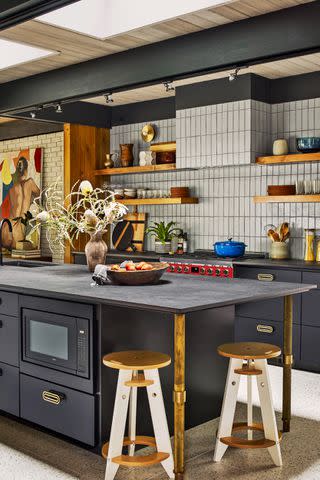
Emily Followill
A black kitchen combines functionality with high-end sophistication, as is characteristic of midcentury modern design. Black cabinets and ceiling beams give this heart of the home a sense of drama, and unique oval-shaped brass pulls dress up cabinet drawers. Floating wood shelves and a wood-planked ceiling warm up the dark tones, and gray subway tile in a vertical design accentuated with dark grout adds a grid-like pattern. A red stove and a bold piece of art in the adjoining room stand out and instantly draw attention. These elements show the power of repetition when it comes to creating a harmonious design that doesn't fall flat despite a mostly monochromatic color palette.
Sage Green Style
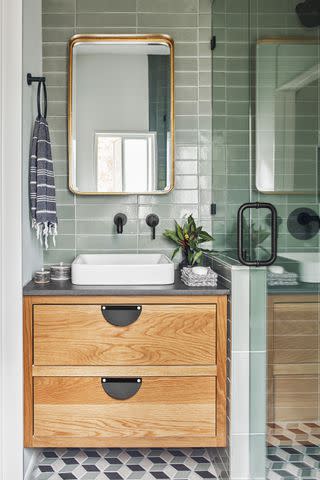
Emily Followill
A muted color palette of sage green, black, white, and gray is embellished with brass accents and a floating wood vanity in this midcentury modern bathroom. Wall and floor tile add color and pattern, with horizontal subway tile on the wall creating a sense of height. Small hexagonal tile on the floor grounds the space. Matte black hardware and a square sink enhance the minimalist look, and a floating vanity adds much-needed storage and a natural element to balance out all the cool tones.
Gray and Brown Color Scheme

Ed Gohlich
A neutral color scheme of browns, grays, beiges, and creams gives this midcentury modern living room a serene feel. Blue and yellow throw pillows add comfort and an accent color, while beige wood-planked walls and an asymmetrical fireplace create a sense of continuity within the space. A gray tufted sofa ties in the dominant color of a patterned area rug, while rich walnut furniture is lightened up with a glass table lamp, terrarium, and decorative vases.
Retro Burnt Orange

Jay Wilde
A saturated pop of orange adds energy to this colorful kid's bedroom. Used through bold geometric wallpaper, a classic midcentury-style swivel desk chair, and small accessories, the burnt shade of orange is a classic midcentury modern color. Its warmth pairs well with the wood tones of a low credenza and flared-leg desk, and its brightness stands out against white walls and curtains. A pop of gold in the form of a pendant light, desk lamp, and sleek curtain rod enhances the warm color scheme.
Muted Pastels
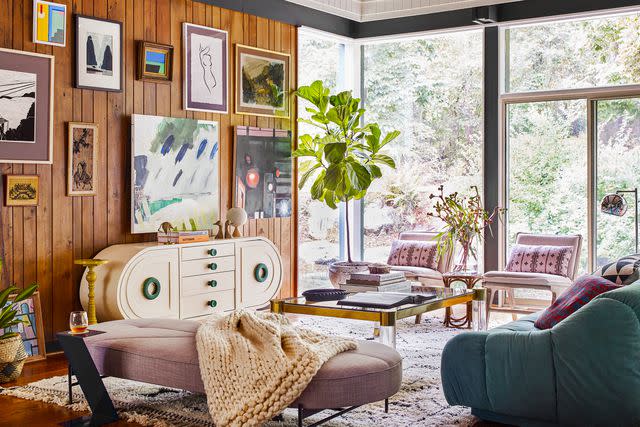
Emily Followill
Every component of this living room exudes midcentury modern home design all over, from the wood paneling to the floor-to-ceiling windows to the low curved furniture and the soft color palette. Brown, black, and white form the structural elements of the space and are lightened up with a glass wall that fills the room with natural light. The windows connect the inside and outdoors, a key element of the design style.
Soft finishes in pastel shades—a plush teal sofa, a purple bench, and patterned throw pillows on armchairs—create depth and dimension while maintaining the living room's serene atmosphere.
Primary Colors
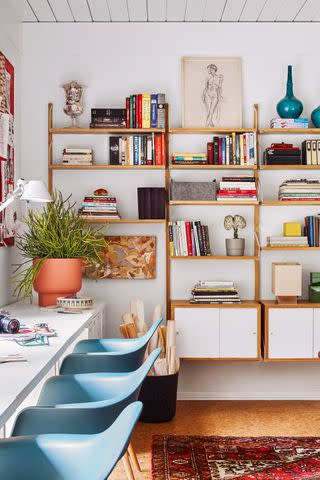
Emily Followill
Two primary colors, red and blue, are used as accent colors in this bright and functional home office. Blue desk chairs and decorative vases complement a red memo board and vintage area rug. A blank canvas of white walls is the perfect backdrop for these bold pops of color that enliven the space. To bring warmth as well as practicality to the home office, wood bookcases are mounted on the wall and a small wooden bench sits in front of them.
Related: 5 Ways to Decorate with Primary Colors for a Retro-Inspired Look
Frequently Asked Questions
What exactly is a midcentury modern design?
As we briefly talked about in the beginning, midcentury modern is defined by a minimalist approach, clean lines, nature-inspired elements, geometric shapes and angles, and bold pops of color. Beyond the basics and décor, a midcentury modern design can also be applied to your home layouts by adding open floor plans, floor-to-ceiling windows, and contrasting materials like glass and metal or marble and leather, for example.
What colors go well in a midcentury modern palette?
Midcentury modern embraces a more neutral yet deep color
palette, which can work as a base for the rest of the décor. White, gray, dark, and olive greens, browns, deep browns, and muted, mustard yellows are often featured in midcentury modern designs as well as natural wood tones. When it comes to patterns, go for geometric, block style, curves, and marble. Give preference to solid, vibrant hues over colorful, complicated patterns.
What kind of furniture is preferred for midcentury modern style?
Characteristically, you’d invest in statement pieces so the rest of the décor can be kept at a minimum. Mix vintage with modern styles of furniture, like a velvet couch in a deep green hue with metal or wooden legs; large wall art in solid hues, combined with elegant floor lamps or ceiling lights. Think of it as the best of both worlds—bold, playful touches to a neutral style; vibrant, edgy pieces over an understated look.
The 7 Best Midcentury Modern Couches of 2023, According to Our Research and Testing
For more Better Homes & Gardens news, make sure to sign up for our newsletter!
Read the original article on Better Homes & Gardens.

